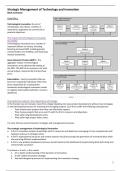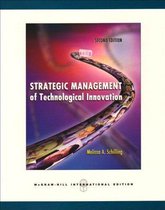Strategic Management of Technology and Innovation
Book summary
CHAPTER 1
Technological innovation: the act of
introducing a new device, method, or
material for application to commercial or
practical objectives.
The impact of technological innovation
on society
Technological innovation has a number of
important effects on society, including
fostering increased GDP, enabling greater
communication and mobility, and improving
medical treatments.
Gross Domestic Product (GDP) = The
aggregate impact of technological
innovation can be observed by looking at
the GDP. The GDP of an economy is its total
annual output, measured by final purchase
price.
Externalities = Costs (or benefits) that are
borne (or reaped) by individuals other than
those responsible for creating them.
Sometimes technological innovation results
in negative externalities (pollution, resource
depletion).
Innovation by industry: the importance of strategy
In the frenetic race to innovate, many firms charge headlong into new product development without clear strategies
or well-developed processes for choosing and managing projects. Such firms suffer the following consequences:
- They initiate more projects than they can effectively support.
- They choose projects that are a poor fit with the firm’s resources and objectives.
- They suffer long development cycles
- They suffer high project failure rates.
It is clear that you need innovation strategies and management processes.
The strategic management of technological innovation
a. A firm’s innovation projects should align with its resources and objectives, leveraging its core competencies and
helping it achieve its strategic intent.
b. A firm’s organizational structure and control systems should encourage the generation of innovative ideas while
also ensuring efficient implementation.
c. A firm’s new product development process should maximize the likelihood of projects being both technically and
commercially successful.
To achieve a, b and c, a firm needs:
1. An in-depth understanding of the dynamics of innovation.
2. A well-crafted innovation strategy.
3. And well-designed processes for implementing the innovation strategy.
1
,CHAPTER 2
Innovation = the practical implementation of an idea into a new device or process.
Technological innovation = the act of introducing a new device, method, or material for application to commercial
or practical objectives.
à Innovation = theoretical conception + technical invention + commercial exploitation.
Sources of innovation
• Firms
• Inventors
• Users
• Universities
• Private nonprofits
• Government-funded research
Creativity
Innovation begins with the generation of new ideas. Ideas are something imagined or pictured in the mind.
Creativity = the ability to produce novel and useful work.
You have creative work at the individual producer level, the local audience level, and the broader societal level.
Translating creativity into innovation
One of the most obvious sources of firm innovation is the firm’s own research and development efforts.
• Research:
o Basic research = research targeted at increasing scientific knowledge for its own sake. It may or may
not have any long-term commercial application.
o Applied research = research targeted at increasing knowledge for a specific application or need.
• Development: activities that apply knowledge to produce useful devices, materials, or processes.
Research suggests that firms that are successful innovators utilize the following sources of information & ideas:
- In-house research and development.
- Linkages to customers or other potential users of innovations.
- Linkages to an external network of firms that may include competitors, complementors, and suppliers.
- Linkages to other external sources of scientific and technical information, such as universities and
government laboratories.
Complementors: Producers of complementary goods or services are complementors.
Innovation in collaborative networks
There is a growing recognition of the importance of collaborative research and development networks for successful
innovation. Such collaborations include (but are not limited to):
- Joint ventures
- Licensing and second sourcing agreements
- Research associations
- Government-sponsored joint research programs
- Value-added networks for technical and scientific interchange
- Informal networks.
Technology clusters
Sometimes geographical proximity appears to play a role in the formation and innovative activity of collaborative
networks. Technology clusters are regional clusters of firms that have a connection to a common technology, and
may engage in buyer, supplier, and complementor relationships, as well as research collaboration.
à One primary reason for the emergence of regional clusters is the benefit of proximity in knowledge exchange.
2
, Proximity and interaction can directly influence firms’ ability and willingness to exchange knowledge. First,
knowledge that is complex or tacit may require frequent and close interaction to be meaningfully exchanged.
• Complex knowledge = knowledge that has many underlying components, or many interdependencies
between those components, or both.
• Tacit knowledge = knowledge that cannot be readily codified (documented in written form).
Firms that are proximate have an advantage in sharing information that can lead to greater innovation productivity.
à Agglomeration economies = the benefits firms reap by location in close geographical proximity to each other.
Studies have indicated that while many innovative activities appear to have some geographic component, the degree
to which innovative activities are geographically clustered depends on things such as:
- The nature of the technology, such as its underlying knowledge base or the degree to which it can be
protected by patents or copyright, and the degree to which its communication requires close and frequent
communication.
- Industry characteristics, such as the degree of market concentration or stage of the industry life cycle,
transportation costs, and the availability of supplier and distributor markets.
- The cultural context of the technology, such as the population density of labor or customers, infrastructure
development, or national differences in the way technology development is funded and protected.
Technological spillovers
While the work on technology clusters has tended to emphasize the “stickiness” of knowledge, a related body of
research has focused on the spread of knowledge and its benefits, this topic is known as technological spillovers.
à A positive externality from R&D resulting from the spread of knowledge across organizational or regional
boundaries.
CHAPTER 3
Technology trajectory: the path a technology takes through its lifetime. This path may refer to its rate of
performance improvement, its rate of diffusion, or other change of interest.
Types of innovation
Four of the dimensions most commonly used to categorize innovations:
1) Product vs. Process innovation
2) Radical vs Incremental innovation
3) Competence enhancing vs. Competence destroying
4) Architectural vs. Component
1 Product innovation versus Process innovation
• Product innovations are embodied in the outputs of an organization, its goods or services.
• Process innovations are innovations in the way an organization conducts its business, such as in the
techniques of producing or marketing goods or services.
2 Radical innovation versus Incremental innovation
Differ in the degree to which an innovation represents a departure from existing practices.
• Radical innovation is an innovation that is very new and different from prior solutions.
• Incremental innovation is an innovation that makes a relatively minor change from (or adjustment to)
existing practices.
3 Competence enhancing innovation versus Competence destroying innovation
• Competence enhancing innovation is an innovation that builds on existing knowledge and skills.
• Competence destroying innovation is an innovation that does not build on the firm’s existing competencies
or renders them obsolete.
Whether an innovation is competence enhancing or competence destroying depends on whose perspective is being
taken. An innovation can be competence enhancing to one firm, while competence destroying for another.
3






